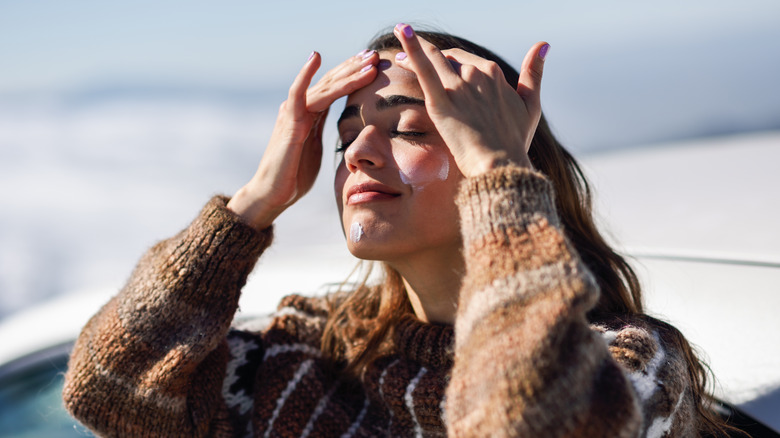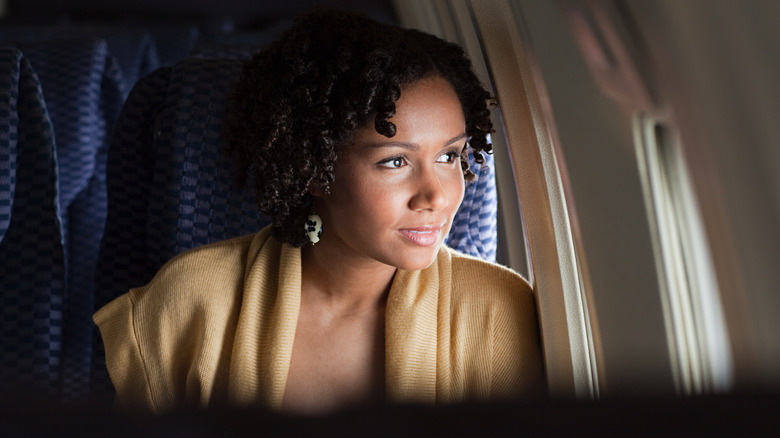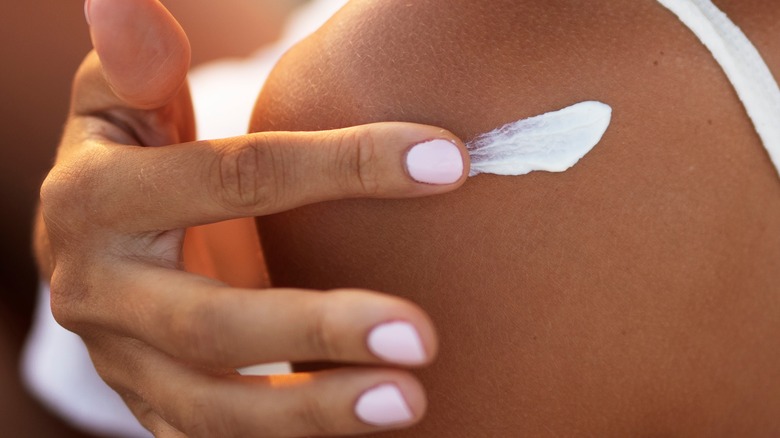Why You Should Put Sunscreen On Before Flying On An Airplane
Sunscreen is a product that most dermatologists would recommend you diligently add to your routine. We know we can't step outdoors, especially on a particularly sunny day, without UV protection. In fact, it's probably a good idea to wear sunscreen every day, whether or not you step outside.
But when we think of flying on an airplane, sunscreen is probably something we think about packing in our checked luggage to be taken out when we arrive at our hotel room. We probably don't give it much thought while sitting on a 10-hour flight waiting for the time to disembark. But as it turns out, we should be.
Our skin is particularly susceptible to sun damage, premature aging, and even cancer at higher altitudes because the ozone layer is thinner up there, according to dermatologists. As Boston, Massachusetts-based double-board certified facial plastic and reconstructive surgeon, Dr. Jaimie DeRosa shared with Newsweek, "I'm a pilot and definitely have learned to be extra-vigilant with sun protection when in the air. The atmosphere helps to scatter damaging UV rays, so the thinner the atmosphere, this protection dwindles and the UV rays are more powerful and damaging."
Where you sit and how often you fly matters too
You might think the best place to sit on a plane is the window seat (and you're not wrong). But window seats, especially with the shutters open, are especially damaging to your skin. While airplane windows (made of plexiglass) do block out most UVB rays, they are not as effective when it comes to UVA rays, according to Dr. Elizabeth Jones, assistant professor of dermatology at Thomas Jefferson University Hospital (via Huffpost).
UVB rays are associated with skin damage and skin cancer, while UVA rays often cause sunburn, skin aging, and wrinkles. A 2015 study assessing the risk of melanoma in pilots and cabin crew found that pilots flying at peak altitude are exposed to the same amount of UV radiation in 56.6 minutes as a 20-minute tanning session on the ground. Another study found that pilots and cabin crew are twice as likely to develop melanoma.
"People who are flying occupationally, they're going to be exposed much more to ultraviolet light given — especially, if they're in the cockpit — the size of the windshield," explained Jones. This means that frequent flyers and those who prefer window seats should also be concerned. Even if you don't fly often and settle into aisle seats instead, you can still be exposed to damaging UV radiation if the shutters are left open. So the best way to stay safe is to apply sunscreen before boarding the plane (and reapply every two hours).
What kind of sunscreen should you be using?
The sunscreen market is large, to say the least and going shopping for what works for your particular skin type can feel daunting. But with hypoallergenic, non-comedogenic, organic, and vegan lines out there, there really is something for everyone if you take the time to look.
Commercial airline pilot Joi Schweitzer recommended using what most dermatologists would advice you to — a face sunscreen with a minimum of SPF 30 protection. "I love Neutrogena SPF 45, and I wear it daily. It feels rich, and it goes on evenly without leaving a film," she told Well+Good.
New Jersey-based dermatologist Marc Glashofer shared with Condé Nast Traveler that he likes using CeraVe Hydrating Mineral Sunscreen SPF 30 Face Lotion. "The best sunscreen is the one you're going to use," he added. You should carry a travel-friendly size and apply it on areas that are most exposed to UV radiation from airplane windows — face, ears, neck, hands, etc. Sunscreen isn't the only protection you can have from the extra damaging rays of the sun while in flight. Dermatologists also recommend wearing long-sleeved protective clothing and closing the shutters whenever you can. Being high up in the clouds and feeling the sun on your face can be exhilarating, but don't forget to protect your skin before you take off.



